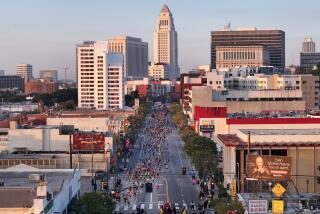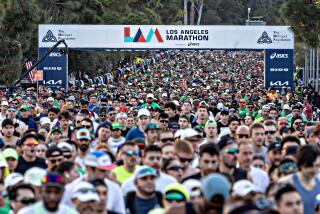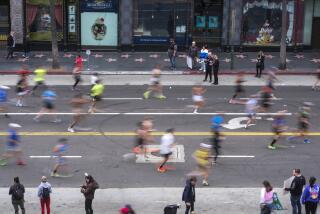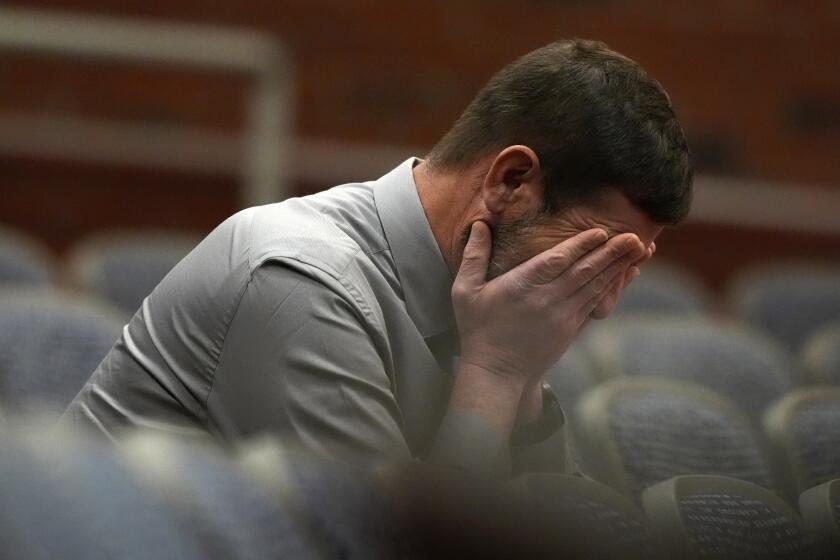Looking back, and forward, to the Boston Marathon
WASHINGTON — On Monday, if all goes according to plan, I’ll be lining up at the start of the Boston Marathon. Let’s just say this up front: I probably shouldn’t be.
I signed up last September, but over the last few months, training season, I’ve been fighting one of those frustrating injuries that just would not come around. Figuring for weeks that it was just a bad hamstring, I stubbornly dragged my bad leg like a piece of wood over snow and black ice, all through a relentless, miserable Northeast winter.
My family and friends thought I was nuts, watching me limp around, and it’s hard to think of a good counter-argument, especially on mornings when it’s 18 degrees and you’re supposed to be doing 10 miles, but every time you squat down your leg seizes in pain.
But running the Boston Marathon is always special, and this one means a lot more. I was there last year, when it turned horrific. I want to be there this year, when it comes back.
For me and thousands of other runners, the notion of running Boston holds a kind of magic. It’s the oldest annual marathon in the world, run every year since 1897 on a course that begins in the small town of Hopkinton and finishes near Boston’s Copley Square.
I knew the Boston lore before I ever got around to training for a marathon: the “scream tunnel” of sign-waving Wellesley College girls (even louder than advertised!), the beery crowds leaving the early Red Sox game at Fenway Park, the giant Citgo sign that leads the way to the finish. There are the notorious Newton hills, which start at pretty much the worst possible point in the race, around mile 16, and finish up at about 21 miles with the steepest one, Heartbreak Hill.
Just at the end, the course makes a little jog, a turn onto Boylston Street: suddenly, thrillingly, the finish line is in front of you. It’s the marathoning promised land: Right on Hereford, left on Boylston.
The race is always on Patriots’ Day, a state holiday in Massachusetts, and that makes it a sort of spring coming-out party for Boston and a treat for the runners: The streets are thick with fans whose parents brought them to watch, and who are now bringing their own kids. They cheer you no matter how bad you’re looking; they know what it took for you to get there.
You have to run a qualifying time in another marathon to get in, and so for a lot of people like me, a news reporter born with a near-total lack of God-given running talent, a ticket to Boston is our trophy, the prize we can maybe win. Smaller marathons use it to drum up business: “flat, fast Boston qualifier,” they promise.
Last year, I was determined to redeem my first Boston performance, in 2011, when I hit the wall around mile 22 and almost passed out at the finish line, slumping to the ground while a nice young volunteer bent over me and asked: “Are you sure you don’t want to go to the medical tent?”
On April 15, 2013, I was excited: I’d had a great training cycle. It was a near-perfect morning, sunny and cool. This time I didn’t fall apart, and when I turned that last corner, I was even able to kick up the pace. I shook hands with a guy next to me: My fastest marathon, I told him. 3:28. I was tickled, for a while.
Thirty-seven minutes after I crossed the finish line, when the bombs went off on Boylston Street, I was already gone, in a friend’s car heading to his house in next-door Brookline. I was standing in the kitchen scarfing a sandwich when the phone rang: a frantic colleague from D.C., worried about my safety.
I headed back to Copley Square, the dread ticking up another notch every time an ambulance came screaming in the other direction. There were so many, one after the other.
Near the finish line, the happy after-race scene had been transformed into a surrealistic landscape of yellow police tape, panicky family members and dazed volunteers with thousand-yard stares, born of their sudden immersion in battlefield triage. Weepy, pale runners who’d been stopped on the course straggled in for hours. It was a relief, at first, to hear early reports that runners were mostly spared, but the reality turned out to be more terrible — the victims were all spectators. Our families and our friends and everybody else who’d come out to cheer us on. My God, little kids.
In the days that followed, the Back Bay streets resembled a war zone, with intersections blocked by military vehicles and hotel lobbies patrolled by police with body armor and automatic rifles. Satellite trucks parked bumper to bumper on the streets. With my press credentials home in D.C., I kept my finisher’s medal in my pocket as a substitute, a way to explain my lack of official ID as I moved from runner back to reporter.
In that running town, it was usually enough. It helped me talk my way past the checkpoint in Watertown where bombing suspect Dzhokhar Tsarnaev was cornered, on that strange last day of the manhunt when the militarized city was shut down, the highways eerily empty of traffic.
I hadn’t planned on running Boston again, not anytime soon, but the bombs changed that. A few days later, doing a piece on the heartbreaking memorial that cropped up near the bombing site, a pile of kids’ toys and cards and running shoes, I spotted a sign on a store: “Boston Doesn’t Blink. 2014 Training Starts Today.” Yes.
I got hurt in October, after I’d already registered, but pressed on with a runner’s typical mule-headedness, ramping up the training until I finally broke down and limped in to see a doctor. One MRI later, I got the news: The hamstring was actually fine; the problem was torn knee cartilage. Wouldn’t heal without surgery.
I said I had the race coming up. “That’s a terrible idea,” the doctor said. Well, I knew that already, but would I hurt it worse? He shrugged. Reluctantly, he gave me a cortisone shot. After a few days, I started testing it again, gingerly. It’s stayed more or less in one piece. Two weeks ago, I finally bought a plane ticket to Boston.
Why does it seem important to be there? I’m not sure I have a good answer. For one thing, who knows whether I will ever be able to qualify again, and I don’t want my last memories of the finish line to be a crime scene. But there is something else too.
There were frozen mornings this winter when I stood on the street and thought about doing the smart thing, and letting it go. And then I’d think about last year, about the shock and the fear and all the victims who are now fighting to walk again, and I’d think, no way. How can I not show up? This race doesn’t belong to two deluded brothers and their homemade bombs. It belongs to us, to greater Boston and to the runners who sweat and struggle to get there.
And then I’d start running.
Times reporters Tina Susman, Alana Semuels, Nathan Fenno and Stacey Leasca will be stationed along the Boston Marathon route and will be sharing updates, stories, photos and more, beginning Monday at 3 a.m. Pacific time, at latimes.com.
More to Read
Start your day right
Sign up for Essential California for news, features and recommendations from the L.A. Times and beyond in your inbox six days a week.
You may occasionally receive promotional content from the Los Angeles Times.







